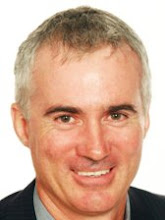20.10.09
Physics for future presidents
7.10.09
Waves waves waves
This is one of those topics where understanding the jargon is a key to success.
- light
- sound
- electromagnetic
- spectrum
- reflection
- refraction
- diffraction
- interference
- resonance
- constructive
- destructive
- curved
- mirrors
- lenses
- critical angle
- boundary
- frequency
- amplitude
- velocity
- wavelength
- pulse
- superposition
30.8.09
Getting towards the sharp end
Yr 12 Physics
29.6.09
Why is AC used rather than DC to supply electricity
Transmission loss
The advantage of AC for distributing power over a distance is due to the ease of changing voltages with a transformer. Power is the product current × voltage (P = IV). For a given amount of power, a low voltage requires a higher current and a higher voltage requires a lower current. Since metal conducting wires have a certain resistance, some power will be wasted as heat in the wires. This power loss is given by P = I²R. Thus, if the overall transmitted power is the same, and given the constraints of practical conductor sizes, low-voltage, high-current transmissions will suffer a much greater power loss than high-voltage, low-current ones. This holds whether DC or AC is used.
Transforming DC power from one voltage to another was difficult and expensive due to the need for a large spinning rotary converter or motor-generator set, whereas with AC the voltage changes can be done with simple and efficient transformer coils that have no moving parts and require no maintenance. This was the key to the success of the AC system. Modern transmission grids regularly use AC voltages up to 765,000 volts. [10]
Alternating current transmission lines do have other losses not observed with direct current. Due to the skin effect, a conductor will have a higher resistance to alternating current than to direct current; the effect is measurable and of practical significance for large conductors carrying on the order of thousands of amperes. The increased resistance due to the skin effect can be offset by changing the shape of conductors from a solid core to a braid of many small wires.
Links:
22.6.09
New Link
MIT Physics
Ideal to use up any spare band width you have on your broadband plan. Not bad for learning about Physics either.
15.6.09
11.6.09
Equivalent Resistance
6.6.09
Homework due Monday 8 June
3.6.09
New Topic Electricity
11.5.09
Competition
8.5.09
Mechanics topic finished
A good first step is check back through your text books and make sure you have attempted all the activities. Please let me know about any areas that you need help with and areas you like to have more explaination and examples of.
9.4.09
7.4.09
Projectile motion
Solving projectile motion problems This link has some worked examples for solving P.M.problems.
25.3.09
8.3.09
Physics Classroom Tutorial
I have just added another site to the list of sites on the right hand side of the blog.
The Physics Classroom Tutorial is an online physics tutorial written for high school physics students. The tutorial was originally developed for physics students at Glenbrook South High School in Glenview, Illinois.
I think you will find the tutorial very useful if you are having difficulty with the Kinematic equations it also covers a number of other mechanics topics.
24.2.09
Relative Motion and Vector Addition
Simple demonstration of vector addition.
16.2.09
12.2.09
11.2.09
Practical
Our first practical.
How can such a simple thing as a model car traveling down an inclined slope become such a mission of data collection, repeats and graphical analysis.
Such are the joys of year 12 Physics.
7.2.09
Welcome to Yr 12 Physics 2009
- To encourage students to use the resources available on the Internet to help in learning new skills and gaining knowledge about physics.
- To provide a mechanism to express dissatisfaction about any aspects of what is happening during the year in physics. (positive feedback is also welcome).
- To discuss or ask questions about any aspect of the course.
- To help you do as well as you possibly can in this subject.
Time to think about refreshing your memory about trigonometry?





